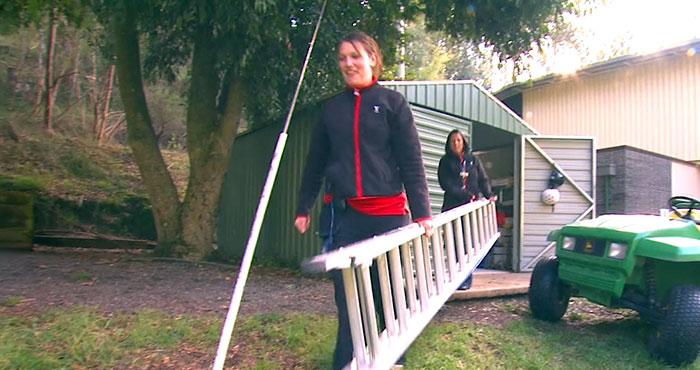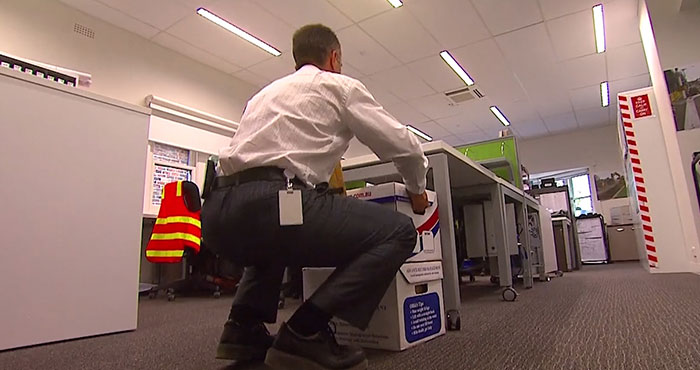

Imagine bending a paperclip, first one way, then the other and repeating that action until suddenly… SNAP! In many ways, the breaking of a paper clip is a great metaphor for a manual handling injury.
Manual handling injuries are hardly ever caused by one, single, isolated action but rather an accumulation of weeks, months, or years of bad habits or techniques.
With each of these bad habits, there is often little to no realisation that you are actually doing damage to yourself, and then it could be something as simple as tying a shoelace and…. bang. Something eventually gives!
Whilst there is very little that you can do about your bad manual handling habits in the past, it is possible to curb the ongoing damage by developing some good manual handling techniques and habits.
Let’s learn more about manual handling and identify 9 manual handling techniques you can practise.
What is manual handling and why is it important?
Manual handling is an umbrella term that encompasses a wide range of activities. Pulling, pushing, carrying, holding, packing, typing, and operating equipment can all fall under the banner of manual handling.
When employers design the workplace thoughtfully and employees practise proper techniques, manual handling should be an occasional process that is not dangerous or hazardous. However, when manual handling processes go wrong, there can be serious consequences both for the injured person and their employer.
In one report published by Safe Work Australia, 45% of claims related to musculoskeletal disorders and injuries were caused by incorrect manual handling. Manual handling workplace injuries have a large economic impact, costing approximately $28 billion every year in Australia. On a personal level, manual handling problems can lead to a range of injuries, including:
- strains and sprains
- back injuries
- nerve compression
- joint injuries
- bone degeneration
- tendon, ligament and muscle injuries
- chronic and acute pain
To counteract the growing impact of manual handling injuries, we highly recommend integrating the following manual handling techniques and habits into your workplace.
01. Assess and modify forceful exertions
One of the very first things you should look at when performing a manual handling risk assessment is the number of forceful exertions you have to carry out.
A forceful exertion is when someone or something has to be lifted, carried, pushed, pulled or restrained. You should take steps to minimise these exertions in the workplace. Some strategies for minimising or modifying these exertions are listed throughout this article. Some workplaces even have a “No Lift, No Injury” policy, which strives to eliminate certain types of manual handling completely and remove the associated risk of injury. While this may not always be practical, you should still think about opportunities to avoid manual handling whenever possible.

If you need to perform a forceful exertion, first consider if an item is too heavy or awkward. If it is, ask for help, whether that’s in the form of a colleague or a lifting/carrying aid. Don’t worry about having to wait for help to arrive. If you need to wait, consider this an investment in your future health and wellness.
02. Plan ahead
If you need to perform a lifting or handling activity, your goal should be to make it as safe and effortless as possible. Planning ahead and putting risk controls in place is the key to safe and easy manual handling activity.
You should try getting into the habit of taking a few moments to assess each task before you tackle it. Before you begin, determine exactly how far the load is going and where it needs to be placed. Consider any manual handling equipment you can use to reduce the manual strain and determine how many people are required for the job.
Plan a path from one end to the next, and ensure obstacles and obstructions are removed before you begin. You should also think about the best places to rest along the way and where you can place your load while you readjust and recuperate.
03. Take a break
If you’re moving an object a long way or you’re performing especially strenuous manual handling tasks, make sure you take breaks during the manual handling activity. You should also take frequent breaks if you are performing repetitive tasks.
Consider stretching after you have completed a manual handling task or while you are taking a break. Sustained, gentle stretching can work wonders for your body after lifting, carrying, or repetitive movement.
04. Pushing vs pulling
If there’s an option between pushing or pulling a load, always choose to push. This allows you to use your body weight to assist with the activity, which is far less strenuous than pulling against the weight of the object.
05. Employ correct lifting techniques
Lifting is the most common form of manual handling. If you decide that an item is not too heavy to lift yourself, here is how you should lift it:
Stand close to the load with your feet apart, creating a stable base for lifting. Once you’re in a stable position, bend at the knees and keep your back straight. Get a firm grip on the object and move it as close to your body as possible.
Tighten your stomach muscles, keep your head erect, tuck your chin in, and lift with a smooth motion by straightening your legs.

As mentioned above, you should make sure that your route is clear of obstructions before lifting and carrying anything.
06. Avoid twisting, bending, and overreaching
In the workplace, look for opportunities to place regularly moved items at around waist height to avoid bending and lifting. If you place tubs and containers on the floor or overhead, you will have to bend, reach, and twist every time those containers need to be accessed.
Whether it’s remote work at home or working onsite, putting items at the right height is one less twist of the paper clip!
07. Put it down before positioning
Have you ever carried an object all the way to its intended destination, only to realise that it needs to be positioned very precisely? All of a sudden, you’re standing there with a heavy load in your hands thinking about how to tackle the next step!
If an object needs to be precisely positioned, put it down first. Take the stress off your body and then think about what to do next. Ideally, you should place the object in its approximate location, so you can then slide it into position without having to perform another lifting action.
To enable this to all run smoothly, make sure you consider positioning in the planning phase. That way, you have somewhere to put the object down at its destination, and you can quickly slide it into place.
08. Practise good posture
Do you practise good posture when operating a keyboard? Awkward postures can be as damaging as repeated poor lifting and carrying practises. If you spend hours in front of a computer, ensure that your workstation has been set up correctly. This includes using a chair that has good back support.
Also consider using a height-adjustable desk that will allow for alternative postures. If that is not possible, give yourself alternative duties that will use different muscles. Regular breaks and stretching sessions will also help.

09. Reduce distance
If you need to perform regular lifting and carrying, the least you can do is minimise the distance you have to travel. This will reduce your risk of injury and make the task much less strenuous. The easiest way to reduce the distance is by considering where each object is stored. When heavy loads are first delivered to your workplace, try and find a storage space for them that is as close as possible to where they will need to be used.
For example, if you have ladders that you take with you to offsite jobs, store them near your work truck or even keep one in the truck if that’s possible.
To improve manual handling, always remember to ask yourself…
- What do I need to move?
- Is there a safer way of doing the task?
- Is there a clear path?
- Is there a mechanical aid I could use?
- Is the load too heavy or awkward to handle on my own?
- Should I seek help?
- Have I stretched and warmed up?
- Is the item between my knees and shoulders to prevent having to bend or lift?
- Can I refrain from twisting whilst lifting and carrying?
A few moments of assessment could save you years of pain and discomfort later!
Are you looking for engaging videos and eLearning products related to manual handling training and occupational health and safety? For more information and training on good manual handling techniques and habits, check out this video on Manual Handling Injury Prevention or explore other products in the Channel 1 range.

